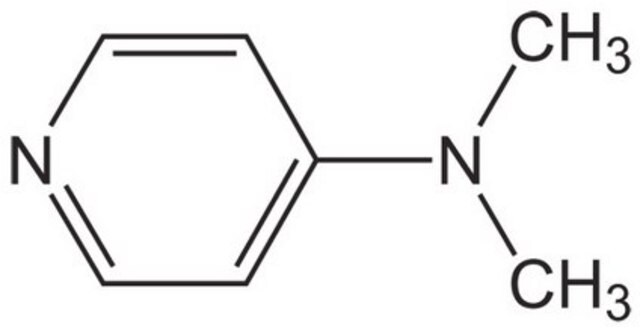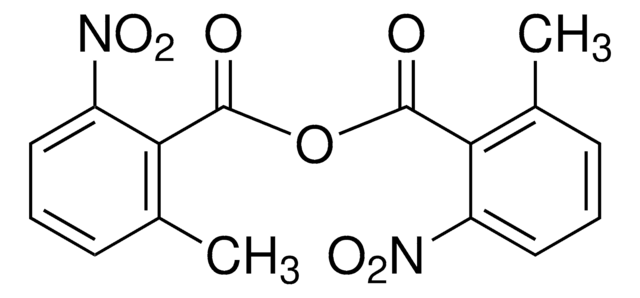107700
4-(Dimethylamino)pyridine
ReagentPlus®, ≥99%
Sinonimo/i:
N,N-Dimethylpyridin-4-amine, DMAP
About This Item
Prodotti consigliati
Grado
reagent grade
Livello qualitativo
Nome Commerciale
ReagentPlus®
Saggio
≥99%
Stato
chips
crystalline powder
flakes
Concentrazione
≤100%
pH
(10,23 at -0,1 g/l at 22 °C)
P. ebollizione
162 °C
Punto di fusione
108-110 °C (lit.)
Solubilità
H2O: 50 mg/mL
Gruppo funzionale
amine
Temperatura di conservazione
room temp
Stringa SMILE
CN(C)c1ccncc1
InChI
1S/C7H10N2/c1-9(2)7-3-5-8-6-4-7/h3-6H,1-2H3
VHYFNPMBLIVWCW-UHFFFAOYSA-N
Cerchi prodotti simili? Visita Guida al confronto tra prodotti
Categorie correlate
Descrizione generale
Applicazioni
- To synthesize 3,5-disubstituted 2,6-dicyanoaniline by reacting malononitrile, aldehydes, and β-nitroolefins.
- For the acylation of alcohols with acid anhydrides under auxiliary base- and solvent-free conditions to synthesize corresponding esters.
- In Baylis-Hillman reaction to form carbon-carbon bond by the coupling of an activated alkene with an aldehyde or ketone.
Note legali
Avvertenze
Danger
Indicazioni di pericolo
Consigli di prudenza
Classi di pericolo
Acute Tox. 2 Dermal - Acute Tox. 3 Inhalation - Acute Tox. 3 Oral - Aquatic Chronic 2 - Eye Dam. 1 - Skin Irrit. 2 - STOT SE 1
Organi bersaglio
Nervous system
Codice della classe di stoccaggio
6.1A - Combustible acute toxic Cat. 1 and 2 / very toxic hazardous materials
Classe di pericolosità dell'acqua (WGK)
WGK 3
Punto d’infiammabilità (°F)
255.2 °F
Punto d’infiammabilità (°C)
124 °C
Dispositivi di protezione individuale
Eyeshields, Faceshields, Gloves, type P3 (EN 143) respirator cartridges
Scegli una delle versioni più recenti:
Possiedi già questo prodotto?
I documenti relativi ai prodotti acquistati recentemente sono disponibili nell’Archivio dei documenti.
I clienti hanno visto anche
Global Trade Item Number
| SKU | GTIN |
|---|---|
| CDS001275-1G | 4061825962719 |
| 107700-25KG | |
| 107700-5KG | 4061833458617 |
| 107700-100G | 4061835554058 |
| 107700-10KG | |
| 107700-1KG | |
| 107700-25G | 4061835554065 |
| 107700-500G | 4061838675477 |
| 107700-5G | 4061835554072 |
Il team dei nostri ricercatori vanta grande esperienza in tutte le aree della ricerca quali Life Science, scienza dei materiali, sintesi chimica, cromatografia, discipline analitiche, ecc..
Contatta l'Assistenza Tecnica.








![1,8-diazabiciclo[5.4.0]undec-7-ene 98%](/deepweb/assets/sigmaaldrich/product/structures/120/564/5b373e23-1624-489c-8efb-692de0f96ffb/640/5b373e23-1624-489c-8efb-692de0f96ffb.png)





